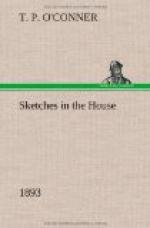the darkness, and the ghosts of dead statesmen and
forgotten scenes of oratory, passion, and triumph.
But as six o’clock was striking, there entered
the yard around the House two figures—similar
in purpose—different in appearance.
Mr. Johnson, of Ballykilbeg, is by this time one of
the familiar types of the House; and, from his evident
sincerity, is, in spite of the terrible and mediaeval
narrowness of his creed, personally popular.
Mr. Johnson is an Orangeman of Orangemen. Now
and then he delivers a speech, in which he declares
that rather than see Home Rule in Ireland, he and
his friends will line the ditches with riflemen.
The Pope disturbs his dreams by night and stalks across
his speeches by day; and there is a general impression
about him that he is resolved, some time or other,
to walk through a good large stream of Papist blood.
He is also a violent teetotaller; and is so strong
on this point that he is ready to shake hands, even
with the deadliest Irish opponent, across the back
of a Sunday Closing Bill. Like most Parliamentary
fire-eaters, he is a mild-mannered man. Time hath
dealt tenderly with him. But still he is well
on to the seventies: his hair, once belligerently
red, is thin and streaked with grey; and he walks
somewhat slowly, and not very vigorously. Dr.
Rentoul is a man of a different type. What Johnson
feels, Rentoul affects. He is a tall, common-looking,
heavily-built, blustering kind of fellow; great, it
is said, on the abusive Tory platform, almost dumb
and utterly impotent in the House of Commons.
These were the vanguard of the Orange army, and they
proceeded to appropriate the first and best seats they
could lay their hands upon.
[Sidenote: Dr. Tanner and his waistcoat.]
Dr. Tanner, soon after this, appeared blazing on the
scene; and sorrow came upon him that any of the enemy
should have forestalled him. Like Mr. Johnson,
Tanner is a Protestant—but, unlike him,
is as fiercely Nationalist as the other is Orange;
and, whenever the waves are disturbed by the Parliamentary
storm, Tanner is pretty sure to be heard of and from.
Viewing the scene of battle strategically, Tanner struck
on an idea which was certainly original. Accounts
differ as to whether he was the possessor of one hat
or several; but tradition would suggest that he had
more than one. It is certain, however, that he
did take off his coat and waistcoat; and stretching
these across the unclaimed land of seats, did thereby
signify to all mankind that the seats thus decorated
were his. But the novel form of appropriation—it
suggests a wrinkle to prospectors in mining countries—was
held to be illegal; and the poor doctor had to content
himself with using the hat, or hats, as a means of
securing seats.
[Sidenote: Colonel Saunderson.]




